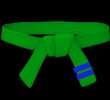Taekwondo 태권도Taekwondo Preschool
Promotion from one geup to the next can proceed rapidly in some schools, since schools often allow geup promotions every two, three, or four months. Students of geup rank learn the most basic techniques first, and then move on to more advanced techniques as they approach first dan. Many of the older and more traditional schools often take longer to allow students to test for higher ranks than newer, more contemporary schools, as they may not have the required testing intervals. View Taekwondo belt levels »

Taegeuk 태극 Poomse
Poomse is the foundation for the teaching of Taekwondo. A poomse, or form, is a detailed pattern of defense-and-attack motions and techniques used in traditional martial arts. Poomse is useful in developing proper kinetics, mental and physical fortitude.
Taegeuk 태극 (in World Taekwondo (WT)) refers to a set of poomse 품새 used to create a foundation for the teaching of taekwondo. A poomse, or form (represented by 形 or 型) is a detailed pattern of defense-and-attack motions and techniques used in traditional martial arts. The word taeguek (the Korean pronunciation of Taiji/T'ai Chi) refers to the important principle in east Asian Taoist thought of the union of yin and yang. Each taegeuk form symbolizes a specific state thought to be indicative of the belt the student currently holds, and is represented in World Taekwondo (WT) by trigrams similar to those found in the four corners of the South Korean flag.
In order to receive a black belt the student must perform all taegeuk forms consecutively. Each Dan (degree of black belt) also has its own associated form, required for belt testing. The first degree form for the World Taekwondo (WT) is called Koryo.

All students studying in World Taekwondo (WT) Kukkiwon style must learn these forms, or taegeuk, to advance to a higher belt level. There are eight taegeuk forms, each one similar to the previous one, but each time with more complicated techniques to display the students' mastery of the techniques learned during lessons, as well as the ability to interconnect these techniques.
Each taegeuk form symbolizes a specific state thought to be indicative of the belt the student currently holds, and is represented in World Taekwondo (WT) by trigrams similar to those found in the four corners of the South Korean flag. Various schools sometimes insert one of a variety of other forms before the first taegeuk (taegeuk il-jang) such as "Basic #1 Pattern »".

Taegeuk #1 Il Jang
- 태극 1장 (Taegeuk Il-jahng)
- Poomse Map Diagram »
- Yellow Stripe Belt (9th geup)
- Number of Movements: 20
The general meaning of this form and associated trigram is Yang, which represents Heaven and Light. Also, this trigram has a relationship to South and Father. The first palgwe form is the beginning of all poomses, the "birth" of the martial artist into taekwondo. This poomse should be performed with the greatness of Heaven.

Taegeuk #2 Yi Jang
- 태극 2장 (Taegeuk Ee-jahng)
- Poomse Map Diagram »
- Yellow Belt (8th geup)
- Number of Movements: 23
The associated trigram of this poomse represents the Lake (joy, a calm sturdy spirit:). Also, related to the symbol is South East and the relationship of the youngest daughter. The movements of this palgwe are aimed to be performed believing that man has limitations, but that we can overcome these limitations. The Lake and its water symbolize the flowing and calm nature of the martial artist. This form is to reflect those attributes.

Taegeuk #3 Sam Jang
- 태극 3장 (Taegeuk Sam-jahng)
- Poomse Map Diagram »
- Green Stripe Belt (7th geup)
- Number of Movements: 30
This trigram represents Fire. Related to this symbol is also East and the relationship of the Second Daughter. Fire contains a lot of energy. The symbol behind the fire is similar to the symbolism of the water in that both can aid and both can destroy. This form is intended to be performed rhythmically, with some outbursts of energy to reflect fire's rhythmic and energetic dualism.

Taegeuk #4 Sa Jang
- 태극 4장 (Taegeuk Sa-jahng)
- Poomse Map Diagram »
- Green Belt (6th geup)
- Number of Movements: approx 27
This trigram represents Thunder. Also, the trigram is strongly connected to northeast and the relationship of the Eldest son. Thunder comes from the sky and is absorbed by the earth, thus, according to the beliefs of the I Ching, thunder is one of the most powerful natural forces. This poomse is associated with power and the connection between the heavens and earth. This poomse is intended to be performed with power resembling the Thunder for which it is named.

Taegeuk #5 O Jang
- 태극 5장 (Taegeuk O-jahng)
- Poomse Map Diagram »
- Blue Stripe Belt (5th geup)
- Number of Movements: approx 32
The trigram associated with this poomse represents Wind. The trigram is also related to southwest and the relationship with an eldest daughter. The I Ching promotes that wind is a gentle force, but can sometimes be furious, destroying everything in its path. As such, it is intended that this poomse is performed like the wind: gently, but knowing the ability of mass destruction with a single movement. The performer and audience should be aware of the duality of the form.

Taegeuk #6 Yuk Jang
- 태극 6장 (Taegeuk Yuk-jahng)
- Poomse Map Diagram »
- Blue Belt (4th geup)
- Number of Movements: approx 31
The trigram associated with this poomse represents Water. Also, there is a relation to West and the relationship with a Second son. The movements of this poomse are intended to be performed like water; flowing, powerful and cleansing. Sometimes standing still like water in a lake, sometimes thriving as a river, sometimes powerful like a waterfall. The water is to symbolize calm and cleansing, while also possessing the attribute of being violent and destructive.

Taegeuk #7 Chil Jang
- 태극 7장 (Taegeuk Chil-jahng)
- Poomse Map Diagram »
- Red Stripe Belt (3rd geup)
- Number of Movements: approx 31
The trigram associated with this poomse represents a Mountain. Also, it represents the northwest and youngest son. The symbolism behind the mountain is the indomitable and majestic nature that all mountains possess. This poomse is intended to be performed with the feeling that all movements are this majestic due to their unconquerable nature.

Taegeuk #8 Pal Jang
- 태극 8장 (Taegeuk Pal-jahng)
- Poomse Map Diagram »
- Red Belt (2nd geup)
- Number of Movements: approx 35
The trigram associated with this poomse represents the Earth. Also, there is a representation of North and Mother. The associated trigram of this poomse is Yin. Yin, here, represents the end of the beginning, the evil part of all that is good. This being the last of the poomse palgwe, it represents the end of the circle and the cyclic nature of the Earth.
General qualities that judges look for in any taekwondo practitioner include proper breathing technique and body control. The diaphragm must be engaged in deep breathing, shallow breathing concentrated in the upper abdomen results in raised shoulders and stressed muscles. The muscles of the body should be lightly relaxed in order to perform the pattern with fluidity, speed and grace. Muscles should only be tensed at the moment of imaginary impact in order to commute maximum power to any individual taekwondo technique. For more information View Key Points »
RESOURCES
This article uses material from the Wikipedia articles "Taegeuk" and "Hyeong", which is released under the Creative Commons Attribution-Share-Alike License 3.0.























